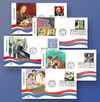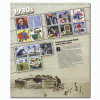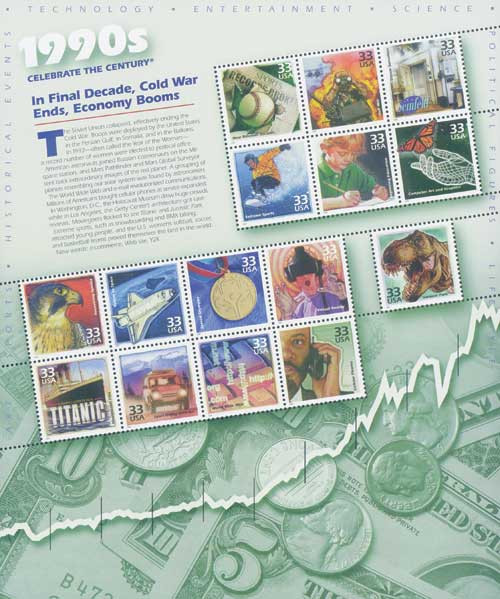
# 3185 - 1998 32c Celebrate the Century: 1930s
US #3185
1998 Celebrate the Century (1930s)
• The fourth sheet in the Celebrate the Century stamp series issued from 1998-2000
• Includes 15 stamps picturing important events from the 1930s
• Each stamp has text on the back detailing the event shown in the front design
Stamp Category: Commemorative
Series: Celebrate the Century
Value: 32¢ First Class Mail Rate
First Day of Issue: September 10, 1998
First Day City: Cleveland, Ohio
Quantity Issued: 188,000,000
Printed by: Ashton Potter (USA) Ltd.
Printing Method: Offset, Intaglio
Format: Panes of 15
Perforations: 11.6
Tagging: Block Tagging
Why the stamps were issued: To commemorate important historical and cultural events from the 1930s that have a lasting legacy in the United States.
About the stamp designs: Picture artwork by Paul Calle of Stamford, Connecticut. The following topics were chosen for the 15 stamps on this sheet (and corresponding back markings of each):
President Franklin D. Roosevelt – Eight days after taking office, President Franklin D. Roosevelt made the first of his radio “fireside chats.” As if speaking directly to each listener, he explained complex issues and the measures being taken to deal with them.
Empire State Building – Completed in 1931, New York City’s Empire State Building has 102 stories and rises 1,250 feet above the ground. For more than 40 years it was the tallest building in the world.
First Issue 1936 LIFE Magazine – Established in November 1936, LIFE magazine opened a new era of photo-journalism. With limited text and photographs on almost every page, it expanded our awareness of current events and the human race.
First Lady Eleanor Roosevelt – Eleanor Roosevelt was an extremely vocal, active, and influential First Lady. During press conferences for women reporters and in her syndicated column, she championed the rights of women, youths, minorities, and the disadvantaged.
FDR’s New Deal – President Franklin D. Roosevelt’s New Deal programs tried to pull the US out of the Great Depression. They provided some relief and addressed the idea of a government-regulated economy.
Superman Arrives 1938 – Created by Jerry Siegel and Joe Shuster, Superman first appeared in 1938. The Man of Steel was the world’s first comic book super hero. His sensational powers and dynamic deeds changed forever the content and style of the comic book.
Household Conveniences – Showing faith in new technology, household purchases focused on electric mixers, refrigerators, pop-up toasters, vacuum cleaners, and irons. The 1930s also saw the spread of sliced bread and packaged frozen foods.
Walt Disney’s Snow White Debuts – In December 1937, Snow White and the Seven Dwarfs premiered as this country’s first feature-length animated film. The movie classic was comprised of 250,000 separate drawings and won a special Academy Award for Walt Disney.
1936 Bestseller Gone With the Wind – Margaret Mitchell’s 1936 novel, Gone With the Wind, portrayed the Old South during the Civil War and Reconstruction. It was a number one bestseller for two years and continues to be sold throughout the world.
Jesse Owens, Six World Records – On the afternoon of May 25, 1935, Ohio State University’s track star Jesse Owens was credited with setting 5 world records and tying another. The following year he earned 4 gold medals in international competition at Berlin.
Streamline Design – Stressing efficiency and speed, streamlined designs were used for cars, planes, trains, buildings, and even appliances. The New 20th Century limited, shown on this poster at the Albany Institute, was an example of the aerodynamic style.
Golden Gate Bridge – After more than four years of construction, the Golden Gate Bridge opened for vehicular traffic May 28, 1937. Boasting a 4,200-foot-long main span, the “International Orange” bridge carried the moderate price tag of $35,000,000
America Survives the Depression – Dorothea Lange’s 1936 photograph of Native American Florence Owens Thompson symbolizes the courage of Americans as they tried to survive the hard times of the Great Depression.
Bobby Jones Wins Grand Slam 1930 – In 1930, amateur Bobby Jones became the first-and-only person to win the Grand Slam of golf. The same year, at the age of 28, he retired from competition.
The Monopoly Game – Produced commercially for the first time in 1933, the Monopoly game became the world’s most famous board game. In a period of economic depression, players enjoyed amassing fortunes and driving opponents bankrupt.
First Day City: The First Day of Issue Ceremony was held at the foot of Cleveland, Ohio’s Terminal Tower Building at Tower City Center. When it first opened in June 1930, the 52-story building was among the tallest buildings in the world and was the tallest west of New York City for 40 years.
About the Celebrate the Century series: The USPS launched the Celebrate the Century series in 1998 to mark the end of the 20th century and herald the arrival of the 21st. The series includes 10 sheets of 15 stamps (150 in total), with each honoring important moments from a different decade (1900s, 10s, 20s, 30s, 40s, 50s, 60s, 70s, 80s, and 90s). At the time of completion, it was the longest and most ambitious commemorative stamp series in US history.
US #3185
1998 Celebrate the Century (1930s)
• The fourth sheet in the Celebrate the Century stamp series issued from 1998-2000
• Includes 15 stamps picturing important events from the 1930s
• Each stamp has text on the back detailing the event shown in the front design
Stamp Category: Commemorative
Series: Celebrate the Century
Value: 32¢ First Class Mail Rate
First Day of Issue: September 10, 1998
First Day City: Cleveland, Ohio
Quantity Issued: 188,000,000
Printed by: Ashton Potter (USA) Ltd.
Printing Method: Offset, Intaglio
Format: Panes of 15
Perforations: 11.6
Tagging: Block Tagging
Why the stamps were issued: To commemorate important historical and cultural events from the 1930s that have a lasting legacy in the United States.
About the stamp designs: Picture artwork by Paul Calle of Stamford, Connecticut. The following topics were chosen for the 15 stamps on this sheet (and corresponding back markings of each):
President Franklin D. Roosevelt – Eight days after taking office, President Franklin D. Roosevelt made the first of his radio “fireside chats.” As if speaking directly to each listener, he explained complex issues and the measures being taken to deal with them.
Empire State Building – Completed in 1931, New York City’s Empire State Building has 102 stories and rises 1,250 feet above the ground. For more than 40 years it was the tallest building in the world.
First Issue 1936 LIFE Magazine – Established in November 1936, LIFE magazine opened a new era of photo-journalism. With limited text and photographs on almost every page, it expanded our awareness of current events and the human race.
First Lady Eleanor Roosevelt – Eleanor Roosevelt was an extremely vocal, active, and influential First Lady. During press conferences for women reporters and in her syndicated column, she championed the rights of women, youths, minorities, and the disadvantaged.
FDR’s New Deal – President Franklin D. Roosevelt’s New Deal programs tried to pull the US out of the Great Depression. They provided some relief and addressed the idea of a government-regulated economy.
Superman Arrives 1938 – Created by Jerry Siegel and Joe Shuster, Superman first appeared in 1938. The Man of Steel was the world’s first comic book super hero. His sensational powers and dynamic deeds changed forever the content and style of the comic book.
Household Conveniences – Showing faith in new technology, household purchases focused on electric mixers, refrigerators, pop-up toasters, vacuum cleaners, and irons. The 1930s also saw the spread of sliced bread and packaged frozen foods.
Walt Disney’s Snow White Debuts – In December 1937, Snow White and the Seven Dwarfs premiered as this country’s first feature-length animated film. The movie classic was comprised of 250,000 separate drawings and won a special Academy Award for Walt Disney.
1936 Bestseller Gone With the Wind – Margaret Mitchell’s 1936 novel, Gone With the Wind, portrayed the Old South during the Civil War and Reconstruction. It was a number one bestseller for two years and continues to be sold throughout the world.
Jesse Owens, Six World Records – On the afternoon of May 25, 1935, Ohio State University’s track star Jesse Owens was credited with setting 5 world records and tying another. The following year he earned 4 gold medals in international competition at Berlin.
Streamline Design – Stressing efficiency and speed, streamlined designs were used for cars, planes, trains, buildings, and even appliances. The New 20th Century limited, shown on this poster at the Albany Institute, was an example of the aerodynamic style.
Golden Gate Bridge – After more than four years of construction, the Golden Gate Bridge opened for vehicular traffic May 28, 1937. Boasting a 4,200-foot-long main span, the “International Orange” bridge carried the moderate price tag of $35,000,000
America Survives the Depression – Dorothea Lange’s 1936 photograph of Native American Florence Owens Thompson symbolizes the courage of Americans as they tried to survive the hard times of the Great Depression.
Bobby Jones Wins Grand Slam 1930 – In 1930, amateur Bobby Jones became the first-and-only person to win the Grand Slam of golf. The same year, at the age of 28, he retired from competition.
The Monopoly Game – Produced commercially for the first time in 1933, the Monopoly game became the world’s most famous board game. In a period of economic depression, players enjoyed amassing fortunes and driving opponents bankrupt.
First Day City: The First Day of Issue Ceremony was held at the foot of Cleveland, Ohio’s Terminal Tower Building at Tower City Center. When it first opened in June 1930, the 52-story building was among the tallest buildings in the world and was the tallest west of New York City for 40 years.
About the Celebrate the Century series: The USPS launched the Celebrate the Century series in 1998 to mark the end of the 20th century and herald the arrival of the 21st. The series includes 10 sheets of 15 stamps (150 in total), with each honoring important moments from a different decade (1900s, 10s, 20s, 30s, 40s, 50s, 60s, 70s, 80s, and 90s). At the time of completion, it was the longest and most ambitious commemorative stamp series in US history.















